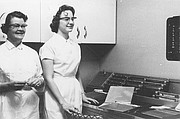St. Luke at 70: Looking back
KRISTI NIEMEYER | Hagadone News Network | UPDATED 2 years, 7 months AGO
Kristi Niemeyer is editor of the Lake County Leader. She learned her newspaper licks at the Mission Valley News and honed them at the helm of the Ronan Pioneer and, eventually, as co-editor of the Leader until 1993. She later launched and published Lively Times, a statewide arts and entertainment monthly (she still publishes the digital version), and produced and edited State of the Arts for the Montana Arts Council and Heart to Heart for St. Luke Community Healthcare. Reach her at [email protected] or 406-883-4343. | May 4, 2023 12:00 AM
When St. Luke Hospital finally opened in 1953, after five years of community labor and donations, an editorial in the weekly Ronan Pioneer proclaimed it “a dream come true.”
From the time bylaws were drawn up in 1945 until the hospital opened in March of 1953, “this project has truly been a community endeavor,” wrote the editor. “Hundreds and hundreds of people have contributed money and labor to its completion.”
Beverly Hamel, who was a nurse from 1953-’56, said nursing duties included laundry, housekeeping and cooking. In those early years, rooms were $8 a day, and if a patient didn’t have cash, trades of labor or homegrown meat or produce could be arranged.
Nurse Mabel Mager, who was named hospital superintendent in 1955, recalled those early years during an interview in 1997. “We didn’t even keep charts. We just had a piece of paper with the patient’s name on it and whether the baby was a boy or girl.”
Maternity stays were a bargain, she said, especially by today’s standards. “It cost $45 for a 10-day stay … and we took care of the baby and did all the washing.”
Dr. Tom McDonald, who practiced medicine at St. Luke for nearly 40 years, from 1959-’98, remembered the hospital when he first arrived in Ronan “was open, but barely surviving. It was a bare-bones structure, minimally staffed and equipped.”
He coped with emergencies and performed routine procedures that now require a phalanx of specialists.
Early in his career, a woman from Round Butte was brought in for surgery and quit breathing as the scrub nurse was administering anesthesia. Dr. McDonald opened her chest and massaged her heart back to life, even though the hospital had none of the proper paraphernalia for such a complex task. “In a few days, the lady was just fine …That was a real eye opener for me.”
Ed Bratton, a longtime county extension agent and board member, recalled how hard they worked to keep the hospital alive. Doctor Charles Thornton, who opened his office in Ronan in 1955, “came up with the idea of asking the community to pledge $1 a month when they were going to reclaim the equipment and furniture,” said Bratton. “Old Doc Brooke was the biggest contributor. He paid $10 a month.”
“For a long time, we gave our first hour of work to the hospital with no pay,” said LaVerne McGreevey, a nurse from that era. “It helped keep us going.”
By 1964, the hospital was on more stable footing, with around 22 employees and a payroll of $51,000. By 1976, the community had raised over $600,000 for a nursing home – now known as St. Luke Extended Care – in a campaign called the Mission Valley Miracle.
By 1985, hospital revenue topped $15 million, and five years later a new wing was added to the nursing home. New clinics began to crop up, first in St. Ignatius in 1993, and in Ronan in 1998. By 2006, the board of directors was envisioning a $33 million building and remodeling project. A year later, contractors broke ground on the 61,000-square-foot addition that closed a block of Main Street.
Doc McDonald, who died in 2018, was on hand to celebrate St. Luke’s 60th birthday in 2013. “One of the great pleasures in my life has been to see it grow and improve,” he said.
Leah Emerson, who served for 25 years as director of nursing and now sits on the hospital’s board, began working as a nurse’s aide at the hospital in the late 1960s.
“It’s been fun watching this place evolve from a little mom-and-pop hospital that struggled day by day to survive,” she said.
Her conclusion, offered during the hospital’s 60th birthday celebration in 2013, still rings true today: “An institution is not made of walls, mortar and bricks. It’s made up of people,” she said. “That’s what has made St. Luke’s a great place to work.”
And as that long-ago editor observed: “Time and again visitors from afar have marveled at the building, its arrangement, its furnishings, its attractiveness within. We can be proud and other communities will point to us as examples of what the cooperation of individuals can do.”
ARTICLES BY KRISTI NIEMEYER

Polson Commission weighs pros, cons of second fire station
The debate over the potential location of a second fire station for the City of Polson elicited questions and suggestions at a public workshop Monday night, held prior to the regular city commission meeting.

Rotarians disperse free dictionaries to third graders in Lake County
To all those cynical adults who think dictionaries have gone the way of dinosaurs, replaced by omnipresent search engines: third graders across Lake County beg to differ.

Rotarians disperse free dictionaries to third graders
To all those cynical adults who think dictionaries have gone the way of dinosaurs, replaced by omnipresent search engines: third graders across Lake County beg to differ.



